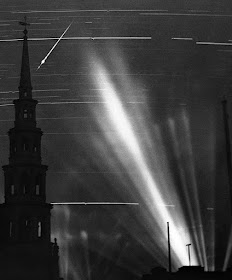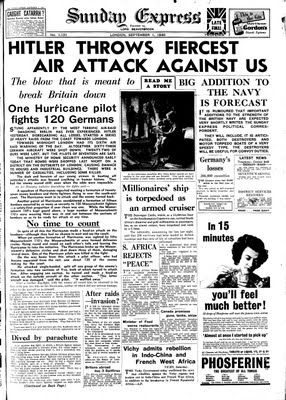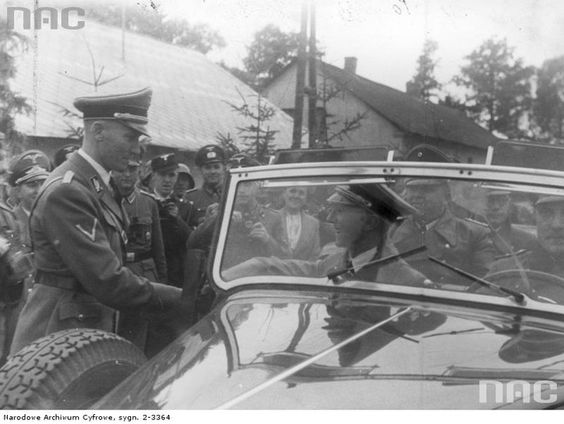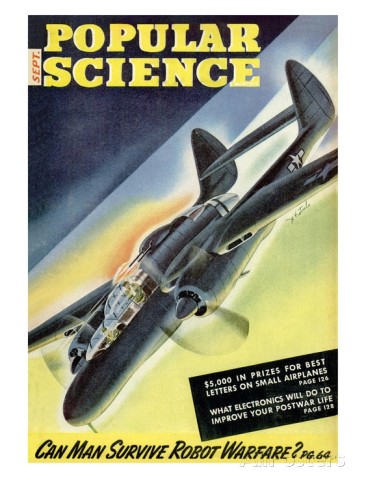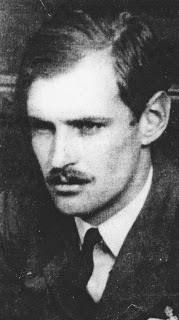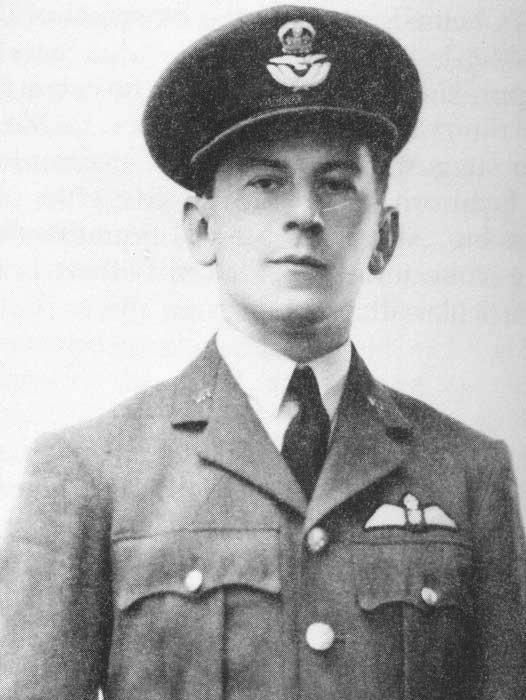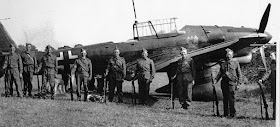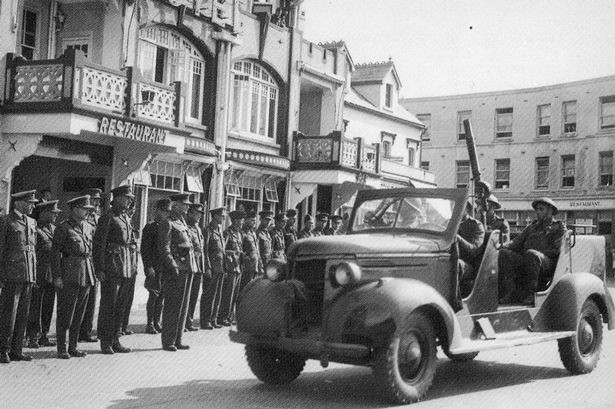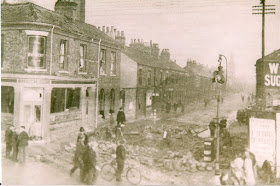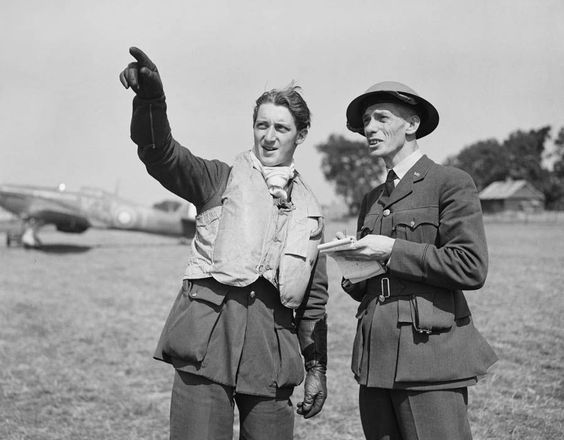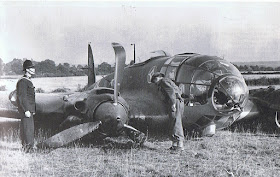Battle of Britain: The Battle of Britain indisputably is reaching its climax on 2 September 1940. The Luftwaffe has found its groove, and it is driving the RAF into the ground with effective, relentless attacks. With the seasons moving along, this provides at least the possibility that Hitler will approve Operation Sea Lion for later in the month. However, it is not just a question of airpower, the state of the Kriegsmarine versus the Royal Navy also is a huge part of the equation (as shown by today's sinking of a German troopship by a Royal Navy submarine with the loss of 1,000 lives). Hitler is still considering his options, and nobody knows what he will decide, but the decision must be made soon.
Reichsmarschall Hermann Goering meets with the fighter commanders in France, including Major Adolf Galland of JG 26 and Major Werner Mölders of JG 51. When Goering asks Galland what he needs, Galland makes the famous response:
The Luftwaffe gets an early start again today. The first major operation is at around 08:00 over Dover. One arm of the force heads for RAF airfields at Eastchurch, North Weald, Rochford, and Biggin Hill - the usual targets. The other arm of the raid heads toward RAF Hawkinge. The RAF has slightly changed its tactics and is focusing more on protecting the airfields than looking for bombers to attack. Fighter Command disperses many of the attacks, but the Short Brothers aircraft works at Rochester is hit, and a Wellington factory on the grounds of the former racetrack at Weybridge takes damage. RAF Gravesend is hit with 11 high explosive bombs that sever all utilities.
The next formation crosses the Kent coastline around noontime, and it is a big one, well over 200 planes. The Luftwaffe fighter escorts successfully occupy the RAF fighters, and the bombers get through. They attack RAF airfields at Biggin Hill, Hornchurch, Croydon, North Weald, Debden, Detling, Eastchurch, and Hawkinge, with Debden taking the most damage. As with Biggin Hill in recent days, the operations center has to be moved outside under the sky when the building housing it is destroyed. There are other bombs dropped at random which destroy numerous civilian residences.
A third major raid develops at around 16:00, again crossing at Kent. Hornchurch airfield takes damage from Dornier Do 17s, Detling loses a hangar, and there is random damage at Eastchurch.
An hour later, yet another formation crosses near Calais. This leads to a massive dogfight over the Thames estuary, but the bombers get through and hit RAF Eastchurch and Detling again. Detling takes the worst of it, receiving 100 bombs and putting the station out of operation for the rest of the day. The attack on Detling has a lucky strike when a bomb dump explodes, causing a tremendous explosion. This puts Eastchurch out of operation, and the Germans notice.
RAF Hornchurch also takes damage. RAF No. 603 Squadron, defending the airfield, disrupts the attack on this vital airfield and causes many of the bombers to turn back.
Yet another raid develops about an hour later around Dungeness at 18:00, but it turns out to be either reconnaissance or a feint, and they head back to France without bombing anything in particular.
The German attacks continue into the night. The Luftwaffe conducts mine-laying operations in the Thames estuary, and attacks are made on Liverpool, Bristol, Birmingham, Wolverhampton, Manchester, and Sheffield. While many bombers pass over London, they do not bomb it. The attacks are scattered far and wide over the length and breadth of England. An attack on freighters off of Kinnairds Head, Scotland around 22:30 leaves two of them damaged.
RAF Bomber Command bombs oil plants at Flushing and Ludwigshafen, Ostend Harbour, munitions plants at Leverkusen and Cologne, the Bosch auto parts plant at Stuttgart, the Dortmund Ems canal, U-boat installations at Lorient, military targets in Genoa, and the German coastal guns at Cap Gris Nez. The British drop incendiaries on the Black Forest in an unsuccessful attempt to start forest fires.
The day is terrible for the RAF, one of the worst of the entire battle. Estimates place the losses for both sides in the 30s, with slightly more Luftwaffe losses. The Bf 110s again take a beating, with elite formation Epr.Gr. 210 losing eight planes. The RAF, though, loses a number of very scarce experienced pilots.
Luftwaffe pilot Hans-Joachim Marseille gets his second kill over Kent, England, but then runs out of fuel and barely makes it back to crash-land on a beach near Calais. Czech pilot Josef Frantisek gets his first victory while serving in the RAF.
A Bf 109 of III,/JG54 piloted by Oblt. Ekkehard Schelcher is shot down over England. His body is found in 1979 and helps lead to the passage of the Protection of Military Remains Act of 1986. Schelcher is buried in the German war cemetery at Cannock Chase.
RAF Nos. 25 and 29 Squadrons receive deliveries of the new Beaufighter fighters.
Battle of the Atlantic: British submarine HMS Sturgeon scores a huge success with possible widespread ramifications. The submarine is patrolling as dusk settles when it spots 3624 ton Kriegsmarine troopship Pionier, complete with torpedo boat escorts, northeast of Skagen, Denmark. The ship appears to be a standard transfer of troops between Norway and Denmark. Sturgeon pumps three torpedoes into the troopship and it goes down quickly, assisted by exploding ammunition. There are roughly 1,000 deaths. This sinking comes at a propitious time, as Hitler is in the latter stages of deciding whether to risk his troops on troopships heading to England. The sinking becomes a central story in the later history of the Battle of Britain, "Their Finest Hour."
The Kriegsmarine's troubles do not end there. Submarine chaser UJ-121 "Jochen" hits a mine and sinks as she approaches Ostend Harbour, West Flanders, Belgium. There are 13 deaths. The sunken ship blocks the Channel used by the 2nd S-Flotilla and has to be cleared.
German raider Widder uses its deck guns and a torpedo to sink 6317-ton British tanker Cymbeline hundreds of miles west of the Canary Islands. The Widder takes 26 of the crew prisoner, but the Captain, First Officer, and Third Engineer escape in a lifeboat to be picked up two weeks later by another passing tanker. There are seven deaths. One of the crew, a 14-year-old deck-boy, later joins the Waffen SS unit "British Free Corps."
U-46 (Kptlt. Engelbert Endrass) torpedoes and sinks 4261-ton British collier Thornlea around 22:00 about 200 miles northwest of Ireland. There are 34 survivors, 3 crew perish.
U-47 (K.Kapt. Günther Prien) is on its seventh patrol in the North Atlantic south of Iceland when it spots 7,463-ton Belgian passenger ship (either no passengers or very few, carrying food as cargo) Ville de Mons. Prien fires three torpedoes and one hits, sinking the Ville de Mons at 17:01. All 54 onboard survive.
Canadian 987 ton sailing vessel Legatus runs aground off Parrsboro Road, Minas Basin, Bay of Fundy and is lost. Everybody survives.
In the Bay of Biscay, the Germans scuttle Norwegian freighter Tropic Sea to avoid capture by the British submarine HMS Truant. The Tropic Sea was captured by the German raider Orion in the Pacific.
British submarine Tigris spots U-58 off the coast of France but its torpedoes miss. The British know that the U-boats are operating out of the French ports and target them while they are transiting from there to the Atlantic.
Convoys OA 208 and MT 158 depart from Methil, Convoy FS 270 departs from the Tyne, Convoy SC 3 departs from St. Johns, Nova Scotia.
Battle of the Mediterranean: Operation Hats, the involved serious of operations to re-supply Malta, is at its climax. Three supply ships (Cornwall, Volo, and HMS Valiant) of Convoy MF 2 make port at Grand Harbour, Malta and are quickly unloaded in case of air attack, with the men of the volunteer infantry brigades helping. The supplies include anti-aircraft guns, personnel and related supplies, and more general supplies such as food and fuel. After taking 4 hours to unload, the three cargo ships leave the harbor and rejoin the fleet, which has been waiting offshore to the south.
Force H launches a second air attack on Caligari as a diversion early in the morning, but poor weather aborts the strike.
Force F (led by battleship HMS Valiant and carrier HMS Illustrious) heads southeast to make contact with the Mediterranean Fleet heading west from Alexandria. Together, they plan to make strikes on targets in the Aegean. This concludes the bulk of Operation Hats.
Italian aircraft shadow the proceedings throughout the morning, and in the afternoon attack the fleet south of Malta. HMS Illustrious launches its defending fighters, and they shoot down one SM 79 bomber and chase the others away. There are other attacks during the afternoon, but no ships are hit.
At Malta, there is a raid around noontime, but the bombers drop their bombs in the sea. The Hurricanes on the island scramble a few times to assist the fleet during its air attacks but make no contact.
The RAF bombs Assab, Eritrea.
Anglo/American Relations: U.S. Secretary of State Cordell Hull and British Ambassador Lord Lothian conclude their agreement to exchange 50 old US destroyers to the UK in exchange for 99-year leases on British bases. These are in the Bahamas, Antigua, St. Lucia, Trinidad, Jamaica, and British Guiana. The bases at Newfoundland and Bermuda are permanent transfers.
German/Romanian Relations: Hitler sends a military mission to Romania.
German/Spanish/Portuguese Relations: Hitler meets with the Spanish and Portuguese ambassadors.
German/Iranian Relations: Hitler meets with the Iranian ambassador.
Free France: The French Settlements in Oceania (Polynesia), led by Tahiti, announces support for Free France.
British Homefront: The government cuts the butter ration from 6oz. to 4oz. This does not affect margarine.
American Homefront: It is the Labor Day holiday in the States. Workers have the day off, and there are public celebrations and events. President Roosevelt presides at a ceremony dedicating the Great Smoky Mountains National Park.
Byron Nelson wins the PGA Championship. This completes his "Career Grand Slam."
Future History: Hans-Joachim Marseille's Bf-109 E-1 was recovered from the beach by the Luftwaffe and later flew operations in the Soviet Union. It was abandoned there, found in the 1990s, restored to flying condition, and occasionally goes up for sale (a few years ago for $4.5 million). It is the only flying example of this version of the plane, powered by a Daimler Benz DB601 engine. It currently is in private hands in Europe.
September 1940
September 1, 1940: RAF's Horrible Weekend
September 2, 1940: German Troopship Sunk
September 3, 1940: Destroyers for Bases
September 4, 1940: Enter Antonescu
September 5, 1940: Stukas Over Malta
September 6, 1940: The Luftwaffe Peaks
September 7, 1940: The Blitz Begins
September 8, 1940: Codeword Cromwell
September 9, 1940: Italians Attack Egypt
September 10, 1940: Hitler Postpones Sealion
September 11, 1940: British Confusion at Gibraltar
September 12, 1940: Warsaw Ghetto Approved
September 13, 1940: Zeros Attack!
September 14, 1940: The Draft Is Back
September 15, 1940: Battle of Britain Day
September 16, 1940: italians Take Sidi Barrani
September 17, 1940: Sealion Kaputt
September 18, 1940: City of Benares Incident
September 19, 1940: Disperse the Barges
September 20, 1940: A Wolfpack Gathers
September 21, 1940: Wolfpack Strikes Convoy HX-72
September 22, 1940: Vietnam War Begins
September 23, 1940: Operation Menace Begins
September 24, 1940: Dakar Fights Back
September 25, 1940: Filton Raid
September 26, 1940: Axis Time
September 27, 1940: Graveney Marsh Battle
September 28, 1940: Radio Belgique Begins
September 29, 1940: Brocklesby Collision
September 30, 1940: Operation Lena
2020
Reichsmarschall Hermann Goering meets with the fighter commanders in France, including Major Adolf Galland of JG 26 and Major Werner Mölders of JG 51. When Goering asks Galland what he needs, Galland makes the famous response:
Ich bitte um die Ausrüstung meines Geschwaders mit Spitfire. (I should like an outfit of Spitfires for my squadron).Goering recognizes the implied insult, but he has just enough of a sense of humor to let it pass and get even later in a clever way. When the Luftwaffe captures an intact Spitfire due to a disoriented RAF pilot landing by mistake in France, Goering has it sent to JG 26:
He wanted Spitfires – Hah! Here is his first, let us see what Galland can do with it!Flying a Spitfire for the Luftwaffe at this point would be tantamount to suicide. Galland, for his part, has the Spitfire given Luftwaffe markings and sends a thank you note to Goering. It is unclear, though, if Galland ever actually used it in combat. More importantly, Galland and Goering now have established a relationship, each taking the measure of the other. Goering - a former fighter pilot himself - shows in later interactions with Galland that he actually likes this kind of swaggering machismo.
The Luftwaffe gets an early start again today. The first major operation is at around 08:00 over Dover. One arm of the force heads for RAF airfields at Eastchurch, North Weald, Rochford, and Biggin Hill - the usual targets. The other arm of the raid heads toward RAF Hawkinge. The RAF has slightly changed its tactics and is focusing more on protecting the airfields than looking for bombers to attack. Fighter Command disperses many of the attacks, but the Short Brothers aircraft works at Rochester is hit, and a Wellington factory on the grounds of the former racetrack at Weybridge takes damage. RAF Gravesend is hit with 11 high explosive bombs that sever all utilities.
The next formation crosses the Kent coastline around noontime, and it is a big one, well over 200 planes. The Luftwaffe fighter escorts successfully occupy the RAF fighters, and the bombers get through. They attack RAF airfields at Biggin Hill, Hornchurch, Croydon, North Weald, Debden, Detling, Eastchurch, and Hawkinge, with Debden taking the most damage. As with Biggin Hill in recent days, the operations center has to be moved outside under the sky when the building housing it is destroyed. There are other bombs dropped at random which destroy numerous civilian residences.
A third major raid develops at around 16:00, again crossing at Kent. Hornchurch airfield takes damage from Dornier Do 17s, Detling loses a hangar, and there is random damage at Eastchurch.
An hour later, yet another formation crosses near Calais. This leads to a massive dogfight over the Thames estuary, but the bombers get through and hit RAF Eastchurch and Detling again. Detling takes the worst of it, receiving 100 bombs and putting the station out of operation for the rest of the day. The attack on Detling has a lucky strike when a bomb dump explodes, causing a tremendous explosion. This puts Eastchurch out of operation, and the Germans notice.
RAF Hornchurch also takes damage. RAF No. 603 Squadron, defending the airfield, disrupts the attack on this vital airfield and causes many of the bombers to turn back.
Yet another raid develops about an hour later around Dungeness at 18:00, but it turns out to be either reconnaissance or a feint, and they head back to France without bombing anything in particular.
The German attacks continue into the night. The Luftwaffe conducts mine-laying operations in the Thames estuary, and attacks are made on Liverpool, Bristol, Birmingham, Wolverhampton, Manchester, and Sheffield. While many bombers pass over London, they do not bomb it. The attacks are scattered far and wide over the length and breadth of England. An attack on freighters off of Kinnairds Head, Scotland around 22:30 leaves two of them damaged.
RAF Bomber Command bombs oil plants at Flushing and Ludwigshafen, Ostend Harbour, munitions plants at Leverkusen and Cologne, the Bosch auto parts plant at Stuttgart, the Dortmund Ems canal, U-boat installations at Lorient, military targets in Genoa, and the German coastal guns at Cap Gris Nez. The British drop incendiaries on the Black Forest in an unsuccessful attempt to start forest fires.
The day is terrible for the RAF, one of the worst of the entire battle. Estimates place the losses for both sides in the 30s, with slightly more Luftwaffe losses. The Bf 110s again take a beating, with elite formation Epr.Gr. 210 losing eight planes. The RAF, though, loses a number of very scarce experienced pilots.
Luftwaffe pilot Hans-Joachim Marseille gets his second kill over Kent, England, but then runs out of fuel and barely makes it back to crash-land on a beach near Calais. Czech pilot Josef Frantisek gets his first victory while serving in the RAF.
A Bf 109 of III,/JG54 piloted by Oblt. Ekkehard Schelcher is shot down over England. His body is found in 1979 and helps lead to the passage of the Protection of Military Remains Act of 1986. Schelcher is buried in the German war cemetery at Cannock Chase.
RAF Nos. 25 and 29 Squadrons receive deliveries of the new Beaufighter fighters.
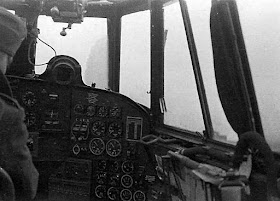 |
| The cockpit of a Dornier Do-17 Z-7 of 2/NJG, operating as a night fighter, 2 September 1940. |
The Kriegsmarine's troubles do not end there. Submarine chaser UJ-121 "Jochen" hits a mine and sinks as she approaches Ostend Harbour, West Flanders, Belgium. There are 13 deaths. The sunken ship blocks the Channel used by the 2nd S-Flotilla and has to be cleared.
German raider Widder uses its deck guns and a torpedo to sink 6317-ton British tanker Cymbeline hundreds of miles west of the Canary Islands. The Widder takes 26 of the crew prisoner, but the Captain, First Officer, and Third Engineer escape in a lifeboat to be picked up two weeks later by another passing tanker. There are seven deaths. One of the crew, a 14-year-old deck-boy, later joins the Waffen SS unit "British Free Corps."
U-46 (Kptlt. Engelbert Endrass) torpedoes and sinks 4261-ton British collier Thornlea around 22:00 about 200 miles northwest of Ireland. There are 34 survivors, 3 crew perish.
U-47 (K.Kapt. Günther Prien) is on its seventh patrol in the North Atlantic south of Iceland when it spots 7,463-ton Belgian passenger ship (either no passengers or very few, carrying food as cargo) Ville de Mons. Prien fires three torpedoes and one hits, sinking the Ville de Mons at 17:01. All 54 onboard survive.
Canadian 987 ton sailing vessel Legatus runs aground off Parrsboro Road, Minas Basin, Bay of Fundy and is lost. Everybody survives.
In the Bay of Biscay, the Germans scuttle Norwegian freighter Tropic Sea to avoid capture by the British submarine HMS Truant. The Tropic Sea was captured by the German raider Orion in the Pacific.
British submarine Tigris spots U-58 off the coast of France but its torpedoes miss. The British know that the U-boats are operating out of the French ports and target them while they are transiting from there to the Atlantic.
Convoys OA 208 and MT 158 depart from Methil, Convoy FS 270 departs from the Tyne, Convoy SC 3 departs from St. Johns, Nova Scotia.
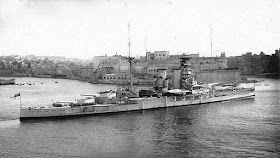 |
| HMS Valiant enters Grand Harbour, Malta on 2 September 1940 (NWMA). |
Force H launches a second air attack on Caligari as a diversion early in the morning, but poor weather aborts the strike.
Force F (led by battleship HMS Valiant and carrier HMS Illustrious) heads southeast to make contact with the Mediterranean Fleet heading west from Alexandria. Together, they plan to make strikes on targets in the Aegean. This concludes the bulk of Operation Hats.
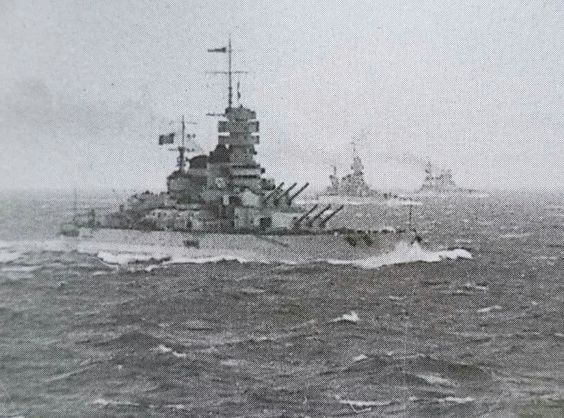 |
| Italian battleships Vittorio Veneto, Caio Duilio and Giulio Cesare at sea during British Operation Hats. They did not give battle and returned to port. |
At Malta, there is a raid around noontime, but the bombers drop their bombs in the sea. The Hurricanes on the island scramble a few times to assist the fleet during its air attacks but make no contact.
The RAF bombs Assab, Eritrea.
 |
| Ellensburg, Washington Rodeo parade, 2 September 1940. |
German/Romanian Relations: Hitler sends a military mission to Romania.
German/Spanish/Portuguese Relations: Hitler meets with the Spanish and Portuguese ambassadors.
German/Iranian Relations: Hitler meets with the Iranian ambassador.
Free France: The French Settlements in Oceania (Polynesia), led by Tahiti, announces support for Free France.
British Homefront: The government cuts the butter ration from 6oz. to 4oz. This does not affect margarine.
American Homefront: It is the Labor Day holiday in the States. Workers have the day off, and there are public celebrations and events. President Roosevelt presides at a ceremony dedicating the Great Smoky Mountains National Park.
Byron Nelson wins the PGA Championship. This completes his "Career Grand Slam."
Future History: Hans-Joachim Marseille's Bf-109 E-1 was recovered from the beach by the Luftwaffe and later flew operations in the Soviet Union. It was abandoned there, found in the 1990s, restored to flying condition, and occasionally goes up for sale (a few years ago for $4.5 million). It is the only flying example of this version of the plane, powered by a Daimler Benz DB601 engine. It currently is in private hands in Europe.
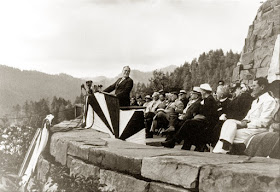 |
| Franklin D. Roosevelt dedicates the Great Smoky Mountains National Park on 2 September 1940. |
September 1, 1940: RAF's Horrible Weekend
September 2, 1940: German Troopship Sunk
September 3, 1940: Destroyers for Bases
September 4, 1940: Enter Antonescu
September 5, 1940: Stukas Over Malta
September 6, 1940: The Luftwaffe Peaks
September 7, 1940: The Blitz Begins
September 8, 1940: Codeword Cromwell
September 9, 1940: Italians Attack Egypt
September 10, 1940: Hitler Postpones Sealion
September 11, 1940: British Confusion at Gibraltar
September 12, 1940: Warsaw Ghetto Approved
September 13, 1940: Zeros Attack!
September 14, 1940: The Draft Is Back
September 15, 1940: Battle of Britain Day
September 16, 1940: italians Take Sidi Barrani
September 17, 1940: Sealion Kaputt
September 18, 1940: City of Benares Incident
September 19, 1940: Disperse the Barges
September 20, 1940: A Wolfpack Gathers
September 21, 1940: Wolfpack Strikes Convoy HX-72
September 22, 1940: Vietnam War Begins
September 23, 1940: Operation Menace Begins
September 24, 1940: Dakar Fights Back
September 25, 1940: Filton Raid
September 26, 1940: Axis Time
September 27, 1940: Graveney Marsh Battle
September 28, 1940: Radio Belgique Begins
September 29, 1940: Brocklesby Collision
September 30, 1940: Operation Lena
2020
